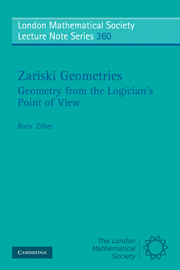6 - Analytic Zariski geometries
Published online by Cambridge University Press: 07 September 2011
Summary
The notion of an analytic Zariski structure was introduced in [PZ] by the author and N. Peatfield in a form slightly different from the one presented here. Analytic Zariski generalises the previously known notion of a Zariski structure of Chapters 8–12 mainly by dropping the requirement of Noetherianity and weakening the assumptions on the projections of closed sets. However, this is not just a technical generalisation. It opens the doors for two completely new classes of examples:
(i) structures which are constructed in terms of complex analytic functions and relations, and
(ii) ‘new stable structures’ introduced by the Hrushovski construction (see Section B.2.2) which in many cases exhibit properties similar to those of class (i).
It is also an attempt to treat the two classes of structures in a uniform way, revealing a common broad idea of what mathematicians mean by analytic. Indeed, the word analytic is used to describe different things in the complex and in the real context, as well as in the p-adic setting. More subtle but similar phenomena are encountered in the context of non-commutative and quantum geometry. We believe that the model-theoretic analysis undertaken in this chapter and in several related papers is a step in this direction.
Definition and basic properties
We introduce analytic Zariski structures as (non-Noetherian) topological structures with good dimension notion for all definable subsets, that is (DP), (FC), and (AF) hold in the same form as in Section 3.1.2 but for a wider family of sets.
- Type
- Chapter
- Information
- Zariski GeometriesGeometry from the Logician's Point of View, pp. 137 - 162Publisher: Cambridge University PressPrint publication year: 2010



